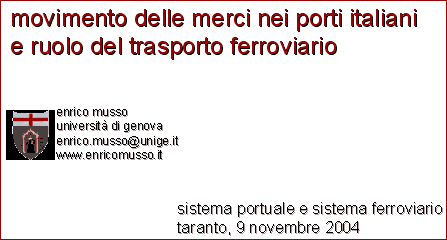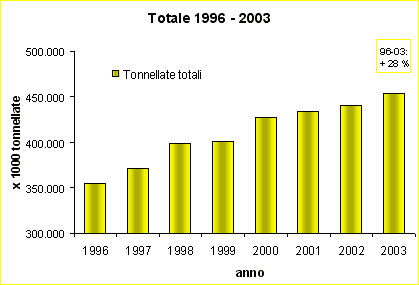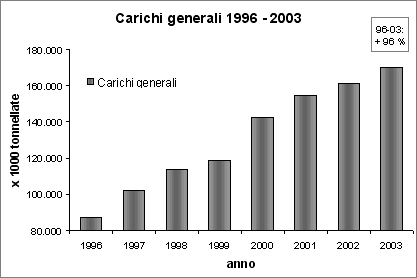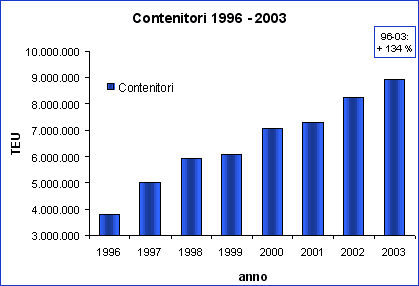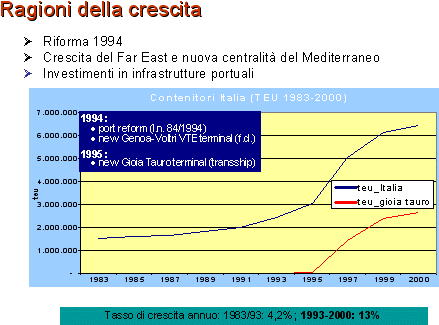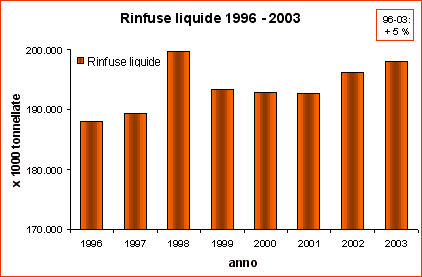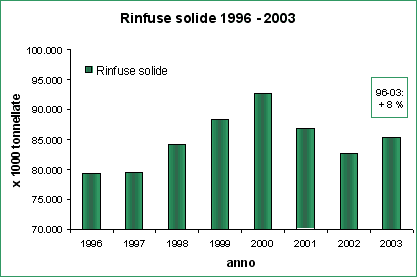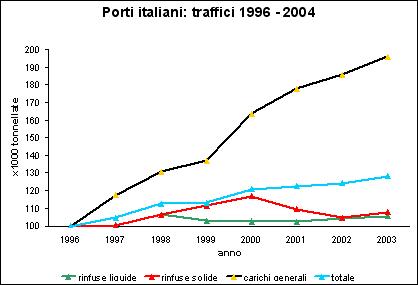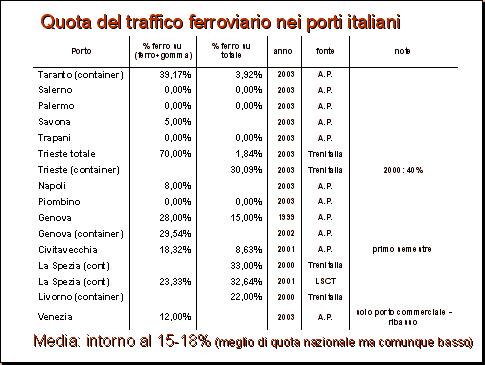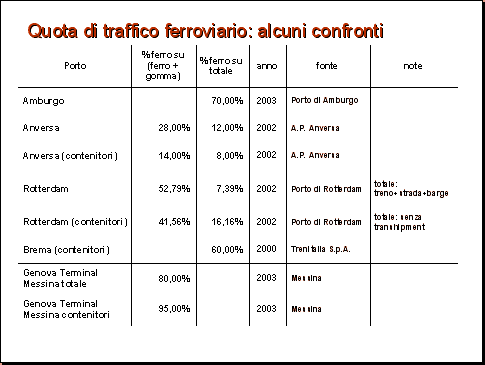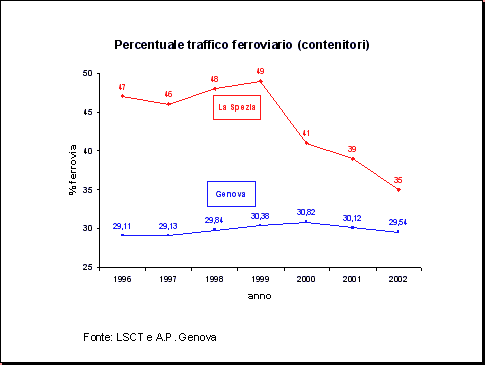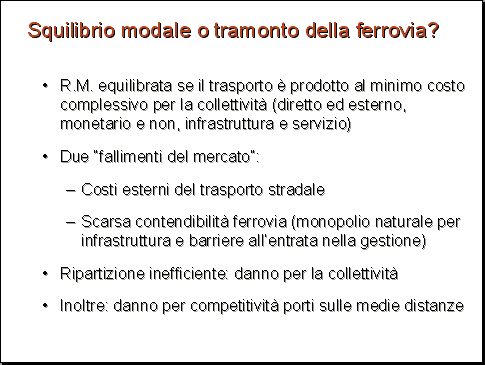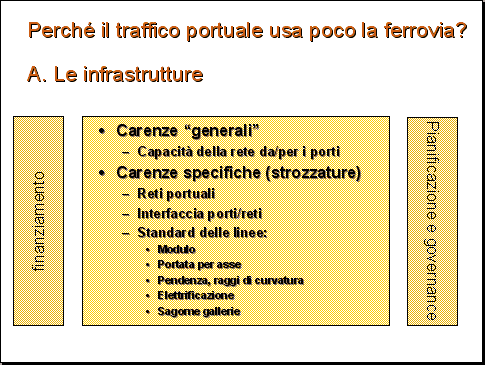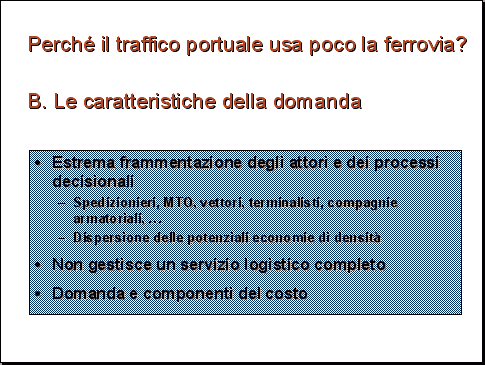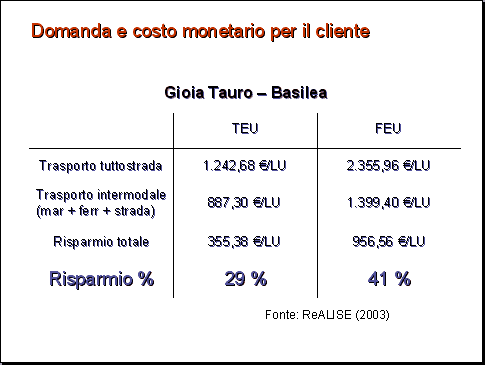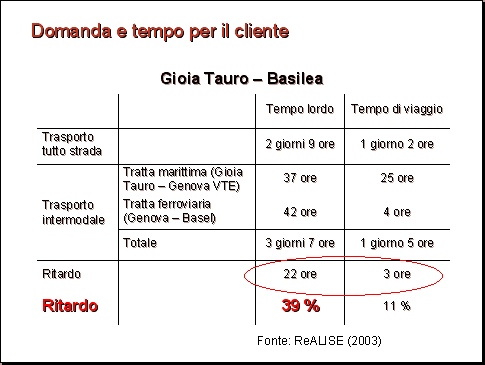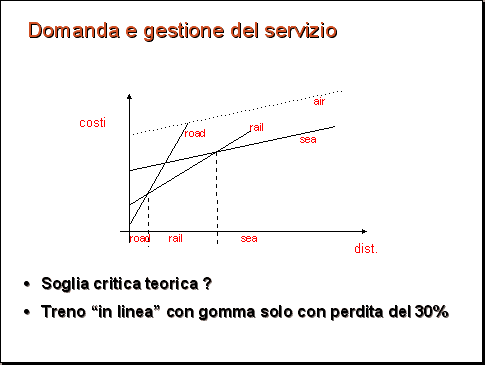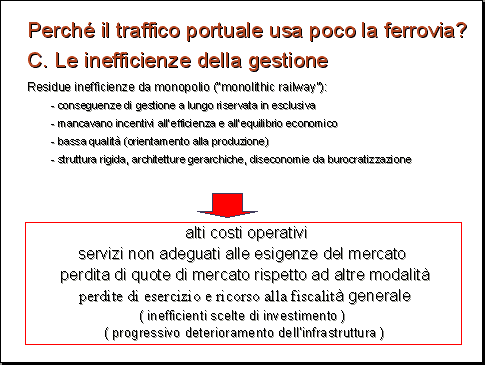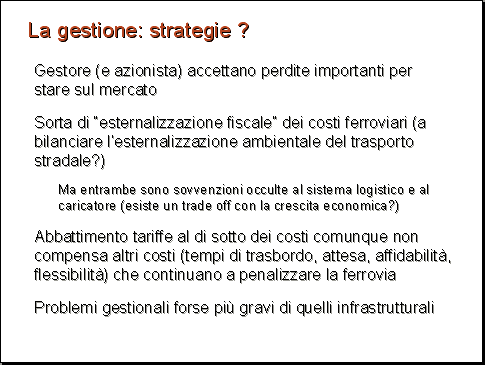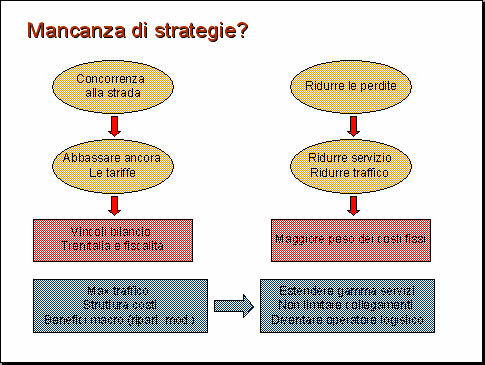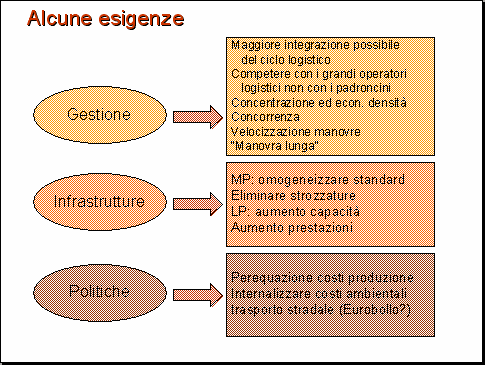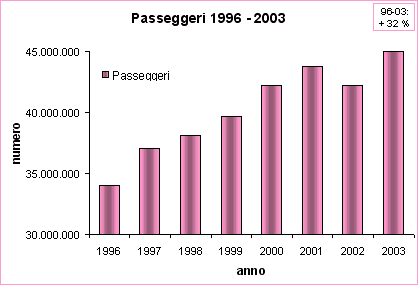Traffici portuali e trasporto ferroviario:
contraddizioni e opportunità
Enrico Musso
Università di Genova
Taranto, 9 novembre 2004
Dalla riforma del 1994 ad oggi il traffico portuale in Italia ha registrato un continuo aumento, sia per il miglioramento dell'assetto gestionale introdotto dalla riforma stessa, sia per l'aumento dei traffici mediterranei conseguente alla nuova geografia del commercio mondiale, sia infine per i grandi investimenti portati a termine o realizzati nei grandi porti hub (Gioia Tauro, Taranto, e in prospettiva Cagliari), a loro volta conseguenza dei primi due fattori menzionati.
A fronte di questo aumento, tuttavia, il trasporto ferroviario da/per i porti non ha registrato né un aumento né una tenuta della quota di mercato. Le (non facili) stime avanzate dagli operatori oscillano fra il 15% e il 18%, più della quota di mercato media del trasporto ferroviario di merci in Italia, ma non abbastanza se si considera che la concentrazione di flussi cui il porto dà luogo crea premesse favorevoli all'utilizzo del vettore ferroviario, sia per i carichi generali sia per le rinfuse.
Naturalmente, il fatto che la quota di mercato della ferrovia sia molto più piccola di quella della strada non implica di per sé che la ripartizione modale non sia equilibrata. "Equilibrata" dovrebbe definirsi la ripartizione che consente una data quantità di trasporto, a parità di qualità, al minimo possibile costo complessivo per la collettività (diretto ed esterno, infrastrutturale e di servizio, monetario e non monetario). Quindi una quota di mercato numericamente modesta potrebbe teoricamente risultare da un'efficiente organizzazione del mercato, e indicare semplicemente che il trasporto ferroviario è oggi superato da altri modi di trasporto concorrenti. In altri termini, in assenza di fallimenti del mercato la ripartizione modale è equilibrata per definizione. Tuttavia il confronto modale in questione è viziato da almeno due rilevanti fallimenti del mercato: la vasta esternalizzazione dei costi ambientali nel trasporto stradale, e la scarsa efficienza del comparto ferroviario derivante dalla scarsa o nulla contendibilità del mercato (nulla nella rete, che è un monopolio naturale, e scarsa nel servizio, che era comunque un monopolio e che rimane scarsamente contendibile anche con la transizione ad un contesto di competizione per il mercato). Ciò porta a ritenere che la ripartizione modale sia effettivamente squilibrata, cioè inefficiente, e che il riequilibrio a favore del ferroviario sia socialmente auspicabile. Tale riequilibrio ha inoltre effetti positivi anche sulla competitività dei porti, poiché un porto con aspirazioni non meramente locali deve competere, in termini di bacini di traffico, su distanze di (almeno) alcune centinaia di chilometri, sulle quali la ferrovia è tendenzialmente più efficace della strada.
Perché, allora, il servizio ferroviario non riesce ad intercettare il maggior traffico portuale, e in molti casi non riesce neppure a mantenere il traffico precedentemente servito?
L'indagine può muoversi in tre direzioni: le condizioni della domanda; le infrastrutture; il servizio ferroviario. Le prime due sono esterne alla gestione del servizio trasporto ferroviario, la terza la coinvolge direttamente.
Dal punto di vista della domanda, l'estrema frammentazione dei processi decisionali fra un numero molto elevato di attori (spedizionieri, MTO, vettori, terminalisti, compagnie armatoriali, etc.) sembra costituire l'elemento più negativo per uno sviluppo del trasporto ferroviario, determinando la dispersione delle potenziali economie di densità che la concentrazione del traffico nel nodo portuale dovrebbe invece portare con sé. A conferma di ciò, potrebbe valere l'esempio di un operatore come Messina, che utilizza il trasporto ferroviario per l'80% dei propri traffici portuali, proprio perché evita la "polverizzazione" degli attori e gestisce un sistema logistico completo per i porti che tocca.
Dal punto di vista delle infrastrutture, si devono distinguere le possibili carenze "generali", riconducibili alla capacità della rete e segnatamente delle linee afferenti ai porti (o eventualmente alla loro collocazione geografica rispetto alle esigenze della domanda), e le possibili carenze "specifiche" legate a strozzature e vincoli nell'interfaccia con i porti (e/o nelle reti all'interno dei porti), agli standard delle linee (portata per asse, modulo, pendenza, curvatura, elettrificazione, sagome) che possono limitarne lo sfruttamento a prescindere dal pieno utilizzo della capacità.
Nella maggior parte dei casi sembra emergere che la rete si congestionerebbe rapidamente in caso di significativa crescita della quota di mercato del servizio ferroviario, ma che solo in alcune situazioni essa è già (almeno di fatto) congestionata. Non sembra cioè essere questo il problema determinante allo stato attuale: i vincoli infrastrutturali non sono (tanto) nella capacità della rete, quanto nelle strozzature e prestazioni. Ciò è particolarmente evidente nel caso del "modulo" dei binari di sorpasso: per un treno merci di 20-22 carri esso dovrebbe essere almeno di 450 m, mentre i moduli di 250 m sono adeguati essenzialmente solo per i treni passeggeri.
Dal punto di vista della gestione del servizio, mentre in linea teorica il costo del trasporto ferroviario dovrebbe essere inferiore a partire da soglie di distanza relativamente contenute, nella realtà i costi di produzione sono sensibilmente maggiori, e le tariffe ferroviarie sono "in linea" con il competitore stradale solo al prezzo di una perdita che gli operatori stimano dell'ordine del 30% del fatturato circa. Ne derivano due considerazioni:
- È tuttora presente, malgrado l'avvio della liberalizzazione nel servizio ferroviario e ormai anche (per lo più) nella gestione delle manovre portuali, un'inefficienza particolarmente elevata nella produzione del servizio, probabile conseguenza del monopolio di cui ha fino ad oggi goduto e della comunque scarsa contendibilità del mercato;
- L'operatore ferroviario e il suo azionista scelgono di conseguire perdite di esercizio importanti, che in qualche modo rappresentano una sorta di "esternalizzazione fiscale" dei costi ferroviari che va a bilanciare l'esternalizzazione ambientale scandalosamente tollerata sul trasporto stradale; tuttavia l'una e l'altra costituiscono (a differenza delle perdite che si conseguono, ad esempio, nella gestione del trasporto pubblico urbano, finalizzate a benefici ambientali), una sovvenzione occulta al sistema logistico e al caricatore; inoltre questo abbattimento delle tariffe rispetto ai costi appare paradossalmente insufficiente per compensare gli altri elementi del costo generalizzato (tempi di trasbordo, attesa, affidabilità, flessibilità) che continuano a penalizzare il trasporto ferroviario rispetto a quello stradale.
Se questa è, a grandi linee, la situazione emersa dall'analisi, occorrerebbero azioni sia sul piano della gestione del servizio, sia sul piano delle infrastrutture, sia ancora sul piano delle politiche dei trasporti.
Sotto il primo profilo, la principale esigenza che sembra emergere à la maggiore integrazione possibile del ciclo logistico, affinché il servizio ferroviario competa con i operatori logistici internazionali, anziché con i padroncini; e affinché si possa concentrare in questo modo il traffico per conseguire significative economie di densità. Altrettanto evidente è l'esigenza di ridurre l'inefficienza "storica" delle imprese ferroviarie, favorendo i comportamenti e le pratiche a tutela della concorrenza, ma anche velocizzamdo le manovre.
Un'opportunità di crescita potrebbe scaturire dalla possibilità di abbinare le manovre alla trazione (la cosiddetta "manovra lunga", che potrebbe servire destinazioni finali e punti di interscambio entro 200 km dal nodo portuale, oggi penalizzata anche dalle politiche tariffarie della rete in materia di tracce senza fornitura di energia).
Sotto il profilo infrastrutturale, occorre:
- nel medio periodo: adeguare gli standard la rete, eliminando le strozzature date da moduli di sorpasso, portate per asse, pendenze, capacità, gallerie, etc. (in alcuni casi si può ipotizzare ipotizzare la rielettrificazione in aree portuali anche in risposta alle menzionate politiche tariffarie della rete);
- nel lungo periodo: potenziare la rete dal punto di vista della capacità e delle prestazioni.
Infine, sul piano della politica del trasporti, è fondamentale traguardare una graduale perequazione dei costi di produzione nei diversi modi di trasporto, in particolare internalizzando i costi ambientali e sociali del trasporto stradale.
Contrariamente a quanto spesso lamentato, gli aspetti gestionali appaiono almeno altrettanto gravi di quelli infrastrutturali. Soprattutto, se questi ultimi sembrano porre principalmente problemi di finanziamento legati all'attuale situazione della fiscalità, e problemi di governance tipici dei processi di pianificazione territoriale, gli aspetti gestionali appaiono carenti fin dalla definizione delle strategie. Se infatti le attuali tariffe sono determinate in funzione dell'esigenza di concorrenza con la strada, ammettendo di conseguenza perdite significative, dovrebbero a quel punto essere abbassate ulteriormente, il che è impossibile per le esigenze di bilancio di Trenitalia e della fiscalità generale. Allo stato attuale, l' "obiettivo" del gestore del servizio in presenza di questi vincoli dovrebbe dunque essere, paradossalmente, quello di ridurre il traffico per ridurre le perdite. D'altra parte, la presenza di rilevantissimi costi fissi dovrebbe portare alla opposta strategia di massimizzare i ricavi. Le strategie del gestore ferroviarie sembrano insomma oscillare, o quanto meno sembrano avere oscillato negli anni recenti, fra questi due inconciliabili opposti, aggravando la già difficile situazione fin qui delineata. Fra questi due orientamenti, per altro, appare probabilmente più efficace quello verso la massimizzazione del traffico, sia per i benefici effetti sulla ripartizione modale, sia per la struttura dei costi prevalentemente fissi, sia infine perché la risposta più efficace alle attuali esigenze e caratteristiche della domanda si dimostra essere quella di estendere la gamma dei servizi offerti (anche alla fornitura di servizi logistici, come nel fortunato esempio di Messina) e non certo quella di puntare sulla riduzione dei costi limitando il numero dei collegamenti.
